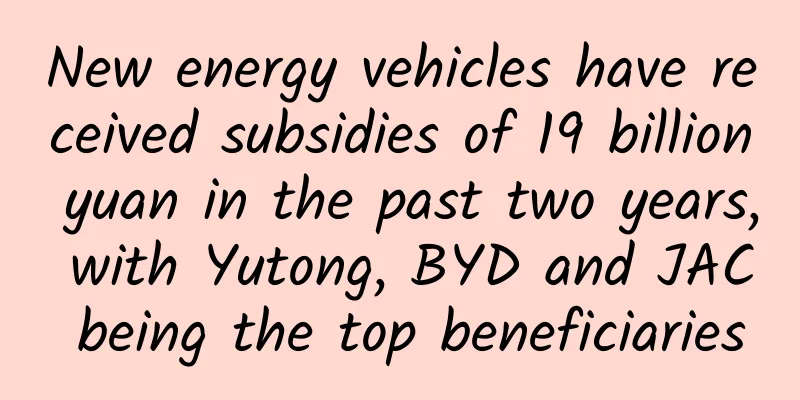New energy vehicles have received subsidies of 19 billion yuan in the past two years, with Yutong, BYD and JAC being the top beneficiaries

|
Recently, the Ministry of Industry and Information Technology announced the "Preliminary Review of Subsidy Funds for the Promotion and Application of New Energy Vehicles in 2017 and Previous Years". After review, it was finally confirmed that the total subsidy funds to be issued to new energy vehicle companies in 2016 and 2017 were about 18.972 billion yuan. Among them, Yutong Bus, BYD, Ankai Bus, JAC Motors, Foton Motor and other listed auto companies have received the most subsidy funds in the past two years. It should be noted that nearly 30% of the first batch of vehicles applied in 2017 did not pass the review.
Stricter review of subsidies for new energy vehicles
According to Cui Dongshu, secretary general of the China Passenger Car Association, the 19 billion yuan in funding only covers the third batch of subsidies in 2016 and the first batch of subsidies in 2017. The third batch of subsidies for new energy vehicles in 2016 was approved for 50,208 vehicles, totaling 12.33 billion yuan; while the subsidies for new energy vehicles in 2017 have just begun, with the first batch of subsidies being 6.64 billion yuan.
In 2016, the state launched three rounds of subsidies for new energy vehicles produced that year. The compliance rate of the models applied for subsidies by enterprises reached 96%, and the subsidy amount reached 41.16 billion yuan. This means that the average subsidy amount for new energy vehicles in 2016 was 147,700 yuan per vehicle. Cui Dongshu analyzed that among them, passenger cars received 43,000 yuan, buses received 370,000 yuan, and special-purpose vehicles received 90,000 yuan. It can be seen that buses and special-purpose vehicles are more efficient in obtaining subsidies.
In 2017, the first batch of applications for promotion numbered 230,616 vehicles, and the number of models that finally met the subsidy requirements was 161,667,000. In other words, only 70% of the vehicles received subsidies in 2017, and the approval rate was significantly lower than that in 2016. The main reason for the vehicles being reduced in 2017 was that they were not connected to the national regulatory platform. In early 2016, the "subsidy fraud" behavior was exposed, and the four-department investigation team conducted a special inspection on the implementation of the promotion and application of new energy vehicles and the use and management of fiscal funds, and required the establishment of a regulatory system for the national, local and enterprise three-level monitoring platforms. At the same time, the national access standards have changed, and the operating data of the vehicles sold must be uploaded to the national regulatory platform.
Subsidies have significantly improved cash flow
The issuance of new energy subsidies to automakers is an important measure for the country to promote the electrification of automobiles. Although the sales of new energy vehicles have increased significantly, the performance of listed companies that previously relied heavily on subsidies has also declined significantly due to various factors such as the decline in new energy vehicle subsidies. In 2017, the net profits of automakers such as Ankai Bus, Haima Automobile, Foton Motor, Zhongtong Bus, JAC Motors and Great Wall Motors all declined by more than 50%. Many new energy vehicle manufacturers such as Ankai Bus and Haima Automobile even suffered losses in 2017.
Industry insiders believe that with the arrival of subsidy funds for new energy vehicle companies in 2016 and 2017, the cash flow and net profit indicators of related companies may improve significantly.
Statistics from the China Association of Automobile Manufacturers show that in 2017, China's production and sales of new energy vehicles were close to 800,000 units, reaching 794,000 and 777,000 units respectively, up 53.8% and 53.3% year-on-year. Among them, the production and sales of pure electric passenger cars were 478,000 and 468,000 units respectively, up 81.7% and 82.1% year-on-year; the production and sales of plug-in hybrid passenger cars were 114,000 and 111,000 units respectively, up 40.3% and 39.4% year-on-year. As a winner of Toutiao's Qingyun Plan and Baijiahao's Bai+ Plan, the 2019 Baidu Digital Author of the Year, the Baijiahao's Most Popular Author in the Technology Field, the 2019 Sogou Technology and Culture Author, and the 2021 Baijiahao Quarterly Influential Creator, he has won many awards, including the 2013 Sohu Best Industry Media Person, the 2015 China New Media Entrepreneurship Competition Beijing Third Place, the 2015 Guangmang Experience Award, the 2015 China New Media Entrepreneurship Competition Finals Third Place, and the 2018 Baidu Dynamic Annual Powerful Celebrity. |
>>: Haier Xinchu smart refrigerator takes the lead in cloud platform deployment
Recommend
Even making coffee is related to mathematics?
Produced by: Science Popularization China Author:...
The brightest gamma-ray burst ever detected! Exploring the most powerful explosion in the universe
Recently, my country's Insight-HXMT satellite...
The free lunch is over: Tesla Superchargers start charging
Tesla Motors announced on Monday that it will end ...
Why is there a hole in a mint? Was it to cut corners?
This article was reviewed by Pa Li Ze, chief phys...
What does the user operation system of a tens-million-level product look like?
Before we start discussing topics related to &quo...
Cash loan ads invaded Douyin, spending 3 million yuan in one day, revealing the list of 20 Internet finance companies
√ With 150 million daily active users, the first ...
Can Panasonic air conditioner technology make a comeback?
"Start-up in seconds, powerful cooling and h...
A must-learn typography tutorial for new media beginners: 3 functions and 10 tips
Now is an era where everyone has a public account...
[Smart Farmers] Extraordinary Decade | A report card on the modernization of agriculture and rural areas over the past decade
Editor's note: Since the 18th National Congre...
Scrcpy open source Android device control tool
Scrcpy is a powerful open source Android device c...
Three ways to be smart in marketing: playing with patterns, leveraging trends and creating hot spots
This is an era of information explosion, an era w...
App Growth | NetEase Cloud Music’s Growth Path!
This article summarizes several growth methods of...
Introduction to Baidu promotion information flow advertising and screen aggregation advertising!
What is a screen-gathering ad? Juping Advertising...
Super powerful German Apollo intends to develop a 1,000-horsepower electric supercar
Last March, German car brand Apollo unveiled the ...
How to write the URL of WeChat mini program? How to set the URL address of WeChat mini program?
Q: Does the external URL address for initiating r...









